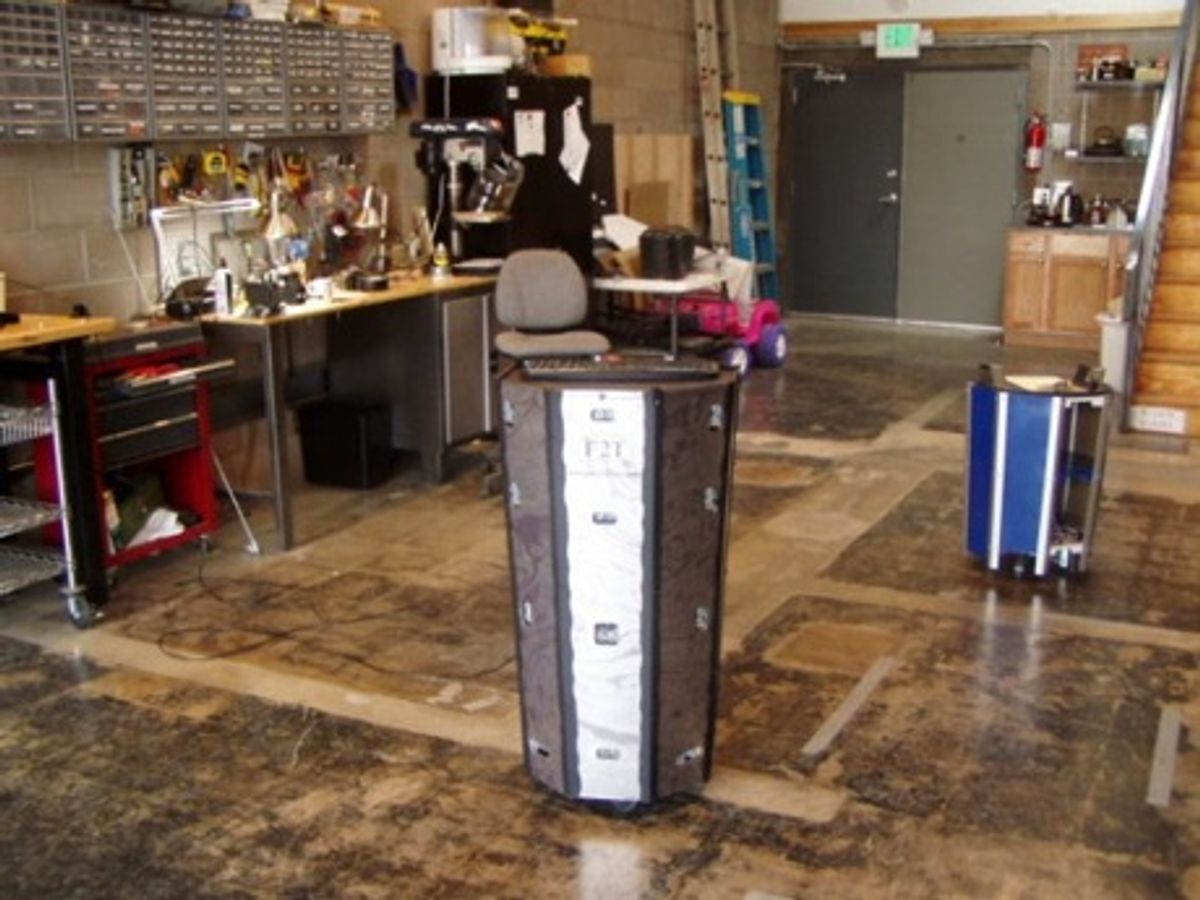It's late on a Friday afternoon at Gamma Two, a robotics development company in Denver, Colo., and that can only mean one thing: It's time for BeerBot.
"Wilma?" Jim Gunderson tells the robot next to him, a cabinet-shaped machine that seems straight out of a 1970s science fiction movie.
"What do you want me to do?" the robot responds.
"Deliver."
"What do you want delivered?"
" Beer."
After driving itself to the kitchen and muttering along the way, Wilma the robot delivers the drink to its owner.
Gamma Two is run by husband and wife team Jim and Louise Gunderson, whose pride and joy these days lies in two autonomous mobile robots named Wilma and Basil.
The Gundersons designed the robots as personal servants that they now plan to commercialize. The machines can respond to voice commands and perform tasks such as delivering drinks and ... well, that's pretty much all they can do now.
But the Gamma Two couple has ambitious plans for the bots. Jim Gunderson, whose title is "cognitive systems architect," says many people would benefit from robots that could work as a nurse's aide or a discreet butler.
People with physical limitations, for example, could use a robot to keep track of their schedules, carry the laundry or groceries, or to follow them around with pills, glasses, phone, or a TV remote control. The robots could also check whether their owners took their pills and if not, send a text message to a caregiver, or even call for help.
The robots [see photo below], have have multiple microcontrollers and a computer running Linux. They use voice recognition to respond to their owner's commands, which according to the Gundersons enables "a very smooth interaction, much like giving commands to a very intelligent, well trained dog."
The Gundersons even programmed the robots with personalities and tempers, so they respond better if you're nice to them, saying "please" and "thank you."
To sense the environment, the robots use arrays of sonars. The sonars send data to the robot's "cybernetic brain," as the couple calls it, which processes the data to identify objects such as chairs, tables, corners, and most important, people. The robots can also recognize places like a kitchen or living room, because each has a specific sonar signature.
Equipped with two motors, the robots can move at up to 9.6 kilometers per hour [6 miles per hour], though they drive much slower when they sense objects around them. An encoder keeps track of their position.
Gamma Two plans to build the robots as customers order them. Each will cost from US $12,000 to 20,000 and take six to eight weeks to assemble. You can also rent them for parties and events.
"A lot of our ideas come out of animated discussions between my husband and I," says Louise, the president and CEO. "We are a team up to and including the fact that we team code together."
The two met in San Francisco in the '70s while Louise was studying chemistry at UC Berkeley. They later moved to Denver where Louise received her master's in environmental science. Twenty years later, they traveled to the University of Virginia to pursue doctorates in computer science (Jim) and systems engineering (Louise). In 1997 they formed Gunderson and Gunderson, which later became Gamma Two.
Humans and animals can perceive things, create mental models, perform manipulations and computations using those models, and then plan and execute actions. A gap between sensing and reasoning is preventing robots from doing the same. The two wrote a book detailing their ideas titled, "Robots, Reasoning, and Reification,” published by Springer in 2008.
Louise, who also studied biology, applies her insight about living systems to her study of robotics. The robots she and Jim design have hardware and software components structured as in a living creature, with a "robotic cerebellum" to handle movement and a "reification engine" to classify objects, for example.
Gamma Two is located in the Arts District of Denver and on the first Friday of every month the Gundersons open up their lab as if it were a gallery. For over a year they've been loading trays of canapes onto Wilma and Basil, which mingle among guests serving crab puffs, cheese, and crackers.
If you are in Denver this August, be sure to stop by the Gamma Two labs. To celebrate the life of Andy Warhol, Jim and Louise will paint their robots' panels with Warhol-like designs. Be the first of your friends to say you've tried robotically served hors d'oeuvres.
And don't forget to say "thank you."
Photos and video: Gamma Two Robotics






